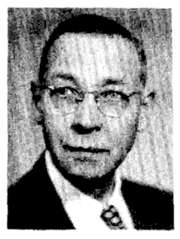John Bertrand Johnson
John Bertrand "Bert" Johnson (October 2, 1887 – November 27, 1970) (né Johan Erik Bertrand) was a Swedish-born American electrical engineer and physicist.[2] He first explained in detail a fundamental source of random interference with information traveling on wires.
Bert Johnson | |
|---|---|
 John Bertrand Johnson | |
| Born | October 2, 1887 Gothenburg, Sweden |
| Died | November 27, 1970 (aged 83) Orange, New Jersey, U.S. |
| Alma mater | Yale University |
| Known for | Johnson–Nyquist noise |
| Awards | Edward Longstreth Medal (1957)[1] IEEE David Sarnoff Award (1970) |
| Scientific career | |
| Fields | Electronic engineer |
| Institutions | Bell Laboratories |
Early life
According to Steve Johnson, described at http://www.jamminpower.com/main/noise.html:
"John Bertrand Johnson was a cousin of my father, Dr. John A. Johnson. Bert was born to my grandfather's sister, who never married, in Sweden. Bert had no schooling in Sweden and lived in extreme poverty. My grandfather sent for him as a teenager and he ended up on their farm in far Northwestern North Dakota [USA]. My grandfather sent Bert to school and he finally graduated from high school and went on get his PhD in Physics from Princeton. I was told that he worked with Einstein when he was at Princeton and went on to be director of Bell Labs ... I met Bert several times, but I was fairly young and most of the family history is lost..I am in the process of trying to piece together more details".
According to the IEEE biography entry in,[2] Johnson was born in the Carl Johan parish of Goteborg, Sweden and christened on October 7, 1887. His birth certificate only recorded his mother's name (Augusta Mathilda Johansdotter 9b. 1866) and his surname is thus derived from his assumed father Carl Bertrand Johnson. He emigrated to the US in 1904 and attended Yale. Johnson became a US citizen in 1928. In 1919 he married Clara Louisa Conger (d.1961) and in 1961 he married Ruth Marie Severtson Bowden. He had two sons by his first marriage, Bertrand Conger and Alan William. John Bertrand Johnson died aged 83 in Orange, NJ, USA, on November 27, 1970.
Career
In 1928, while at Bell Telephone Laboratories he published the journal paper "Thermal Agitation of Electricity in Conductors". In electronic systems, thermal noise (now also called Johnson noise) is the noise generated by thermal agitation of electrons in a conductor. Johnson's papers showed a statistical fluctuation of electric charge occur in all electrical conductors, producing random variation of potential between the conductor ends (such as in vacuum tube amplifiers and thermocouples). Thermal noise power, per hertz, is equal throughout the frequency spectrum. Johnson deduced that thermal noise is intrinsic to all resistors and is not a sign of poor design or manufacture, although resistors may also have excess noise.
Field-effect transistor
Johnson was possibly among the first people to make a working field effect transistor, based on Julius Edgar Lilienfeld's US Patent 1,900,018 of 1928. In sworn testimony to the U.S. patent office in 1949, Johnson reported "...although the modulation index of 11 per cent is not great,...the useful output power is substantial...it is in principle operative as an amplifier".[3] On the other hand, in an article in 1964 he denied the operability of Lilienfeld's patent, saying "I tried conscientiously to reproduce Lilienfeld’s structure according to his specification and could observe no amplification or even modulation."[4]
See also
- Johnson–Nyquist noise
- Timeline of thermodynamics, statistical mechanics, and random processes
References
- "Franklin Laureate Database - Edward Longstreth Medal 1957 Laureates". Franklin Institute. Archived from the original on December 28, 2013. Retrieved November 23, 2011.
- Johnson biography, p. 2
- Robert G. Arns, "The other transistor: early history of the metal-oxide-semiconductor field-effect transistor," Engineering Science and Education Journal, October 1998
- J. B. Johnson, "More on the solid-state amplifier and Dr. Lilienfeld," Physics Today, May 1964
External articles and references
- J. B. Johnson, "Thermal Agitation of Electricity in Conductors". The American Physical Society, 1928.
- Federal Standard 1037C and MIL-STD-188